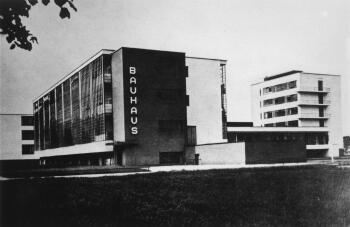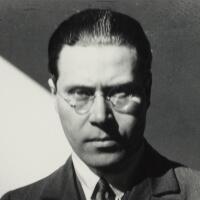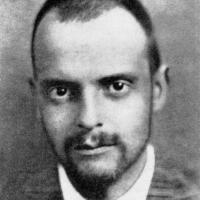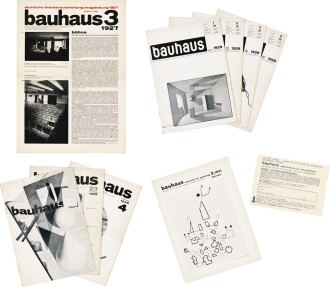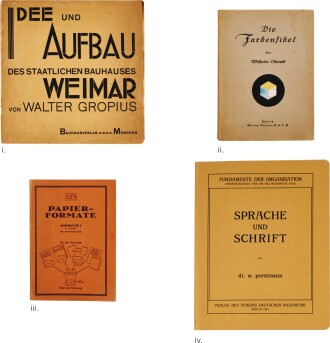About 包浩斯
What is the Bauhaus?

The Bauhaus was a German art school which opened in 1919 and ran until 1933. The school was only open for fourteen years and graduated fewer than 500 students, but it revolutionized the ways in which we think of artistic production, and it achieved legendary status as a pedagogical system for the arts. The Bauhaus collapsed the divide between fine art and craft, and sought to break down the systems which privileged painting and sculpture over any other form of design. The educational system at the Bauhaus, designed by its founder and leader Walter Gropius, provided students with a six-month foundational course in a broad range of design, which introduced the principles of production in various craft and media, after which students would take workshop courses in woodworking, furniture design, textiles, typography, stained glass, metalworking, photography, light fixtures, and many other areas of design in addition to painting and sculpture.
The Bauhaus approach to production was distinctly modern, emphasizing the mass producibility of objects through an economic use of material, and advocating for simple design in which form is based on function. For Gropius and the Bauhaus professors, art was found in the design of an object or building, not in the ornamental paintings which decorated it. Gropius invited leading figures of the avant-garde to instruct at the Bauhaus, including Joseph Albers, Vasily Kandinsky, Paul Klee, Marcel Brauer, László Moholy-Nagy, among many others, who solidified the excellence and experimentation of the school. During the fourteen years of its existence, the Bauhaus transfigured the educational system that had dominated the west for many previous centuries, from the classical academic system, to the collapse of high art into design, under an increasingly hostile governing body.

What are Bauhaus stylistic characteristics?
The professors and students of the Bauhaus worked in a wide range of media and aesthetics. The school’s approach had an underlying interest in simplicity, clean lines, and ease of use and production, resulting in iconic new forms of everyday objects, architecture, and sculpture. The Bauhaus embraced new technologies of photography and film, which produced some of the most experimental forms and objects of the avant-garde; László Moholy-Nagy’s photograms and light space modulators questioned the means of documenting space, movement, and light, indelibly impacting the intellectual approach to the cinematic apparatus across Europe. Typography was an avenue through which the Bauhaus made pioneering innovations, inventing new sans-serif fonts for an efficient, highly legible, and simplified new form of written language.
What is the Legacy of the Bauhaus?

The Bauhaus continues to inform artistic educational systems today not only because of its huge paradigm shifts and successful re construction of the general approach to the arts, but also because following the rise to power of the Nazis and the disbanding of the school, many Bauhaus professors made their way to America, where they continued teaching with the same general foundational ideas that have impacted American art schools and programs. Gropius and Breuer taught at Harvard, Moholy-Nagy went to Chicago where he set up the New Bauhaus, and Josef Albers taught at the Yale Art School. The Bauhaus functions as the groundwork for the aesthetics and practical approaches of twentieth and twenty-first century design. IKEA, contemporary logos, iPhones, and many everyday objects of the twenty first century have their basis in the ideas which came from the Bauhaus.
Timeline & History of the Bauhaus

Walter Gropius, circa 1915 1919Walter Gropius founds Das Statliche Bauhaus, or the state school of building: Bauhaus for short. He immediately established its basic approach which unified design with fine art.
Design for a Bauhaus Exhibition Poster © President and Fellows of Harvard College 1923The Bauhaus organizes its first exhibition, Art and Technology: A New Unity with works by Bauhaus professors and students.
The Bauhaus building in Dessau was built in 1925–26 by Walter Gropius. 1925The Bauhaus moves from Weimar to Dessau, onto a campus designed by Gropius through the intellectual and practical approaches of the school. It is here that the iconic Bauhaus steel and glass workshop building is found.
Architect Ludwig Mies Van Der Rohe standing in front of a building model of the Illinois Technical Building. (Photo by Arthur Siegel/The LIFE Images Collection via Getty Images/Getty Images) 1930Architect Mies van der Rohe succeeds Gropius as Bauhaus director, and promotes an emphasis on architectural design for public spaces.
Roof Deck of the Lincoln Massachusetts home of Walter and Ise Gropius 1933The Gestapo raids the Bauhaus and the Nazis shut down the Bauhaus, sending its members fleeing to various places including the United States.
University Archives and Special Collections, Paul V. Galvin Library, Illinois Institute of Technology 1937László Moholy-Nagy opens the New Bauhaus in Chicago, based on the original principles at Gropius’ Bauhaus, which he runs until his death in 1946.
December 7, 1938–January 30, 1939. Photographic Archive. The Museum of Modern Art Archives, New York. IN82.7. Photograph by Soichi Sunami. 1938The Museum of Modern Art in New York mounts an exhibition titled Bauhaus: 1919–1928, displaying nearly 700 objects produced by the school.
Artists
Who Was at the Bauhaus?
Gropius designed the Bauhaus curriculum to allow for the lead professor of the given moment to guide the foundation course based on their particular interests and approaches. The head professor of the foundation course changed over the course of the fourteen years of the Bauhaus, amongst five professors. Johannes Itten guided the foundation course to largely be based on social theory of collectivity. It then shifted to Laszlo Moholy Nagy, Josef Albers, Paul Klee, and Vasily Kandinsky. Gropius would purposefully hire graduated Bauhaus students as new professors, allowing for younger voices to improve the curriculum through student experience; as a result, over time, the Bauhaus generally shifted away from craft and toward industrial design.
Bauhaus Artists
The Bauhaus at Auction
Sell
Have Something to Sell?
Have Something to Sell?
Get Started




